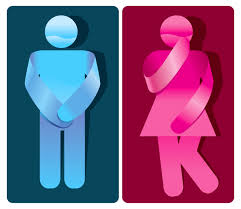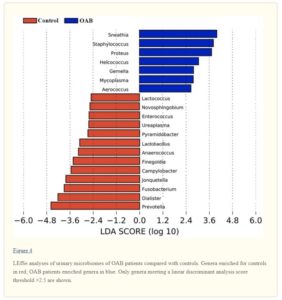
We’ve looked at the effects of gut microbiome on health1 2 3 4 5 , but what about urinary microbiome and its effect on our bodies and brains? Bet you’ve never thought of this topic before! So, if diet affects the gut microbiome, then does it also affect what goes on in our bladders, too? This might be of interest not only to women with overactive bladders, but to any of us who want to ensure that as we age we keep the contents of our bladder healthy and…where they should be.
The November 2017 study6 we are concerned with looks at how changes to the urinary microbiome (yes, there’s one there as well) will affect the lower urinary tract.
Overactive bladder (OAB) is a fairly common problem with complex causes. It is also usually associated with psychological diseases. This study aimed to describe how female urinary microbiome is associated with OAB and also what the relationships are between the microbiome and associated psychological factors.
Urine samples were take from 30 women with and 25 women without OAB. The results were then analysed and compared.
The results showed that there was less bacterial diversity and richness in the urine samples of the women with compared to the women without OAB.
Additionally, and this is where there is an interesting link up with my earlier article7 in the two groupings of gut enterotypes into which all humans fit (viz. Bacteroides and Prevotella) , the OAB and non-OAB bacterial communities were significantly different.
In the OAB group, 7 genera were increased and 13 were decreased compared with the non-OAB group (see chart below for details). What I would like to draw your attention to, if I may, is the presence of Prevotella in the list of those 13 that were comparatively scarce in the OAB group. If you recall, Prevotella is associated with the long-term diets of meat eaters and, rather worryingly, also with a significantly higher risk of colon cancer.8

When it came to responses to scores on the Self-Rating Depression Scale, both richness and diversity of urinary microbiome in the OAB group were negatively associated with a higher score on the scale: that is, more depression = a less diverse and rich urinary microbiome. There were also some significant differences in the bacterial genera of the OAB women who had depression and the OAB women who did not have depression.
The researchers concluded that: “The aberrant urinary microbiome with decreased diversity and richness may have strong implications in pathogenesis and treatment of OAB. Psychological conditions were correlated with characteristics of urinary microbiome in women with OAB. Further research is needed to understand the connection between central nervous system and urinary microbiome.”
Whilst conclusions drawn did not consider diet as a causal factor (since this was not the aim of the study), one would suspect that it plays a part in the health of urinary microbiome just as it has been shown to be related to the health of gut microbiome. And, since the latter is thought to have a causal relationship with a whole range of diseases, it wouldn’t be too extreme to consider that a similar causal relationship exists with urinary and comorbid diseases.
More research is needed, but in the meantime, it would appear to be sensible to err on the side of caution and stick to a largely (or, ideally, wholly) plant-based diet. What do you think?
References
- Two Types of Gut Bacteria: Plant Eaters’ & Meat Eaters’ [↩]
- Depression is Linked to Inflammation [↩]
- Fibromyalgia, Probiotics & Gut Microbiota [↩]
- Physical Activity for Disease Prevention & Healthy Gut Microbiome [↩]
- Multiple Sclerosis (MS), Serotonin & Gut Microbiota [↩]
- Urinary Microbiome and Psychological Factors in Women with Overactive Bladder. Wu P, Chen Y, Zhao J, Zhang G, Chen J, Wang J, Zhang H. Front Cell Infect Microbiol. 2017 Nov 27;7:488. doi: 10.3389/fcimb.2017.00488. eCollection 2017. PMID: 29230385. [↩]
- Two Types of Gut Bacteria: Plant Eaters’ & Meat Eaters’ [↩]
- So eating which foods results in which enterotype? [↩]